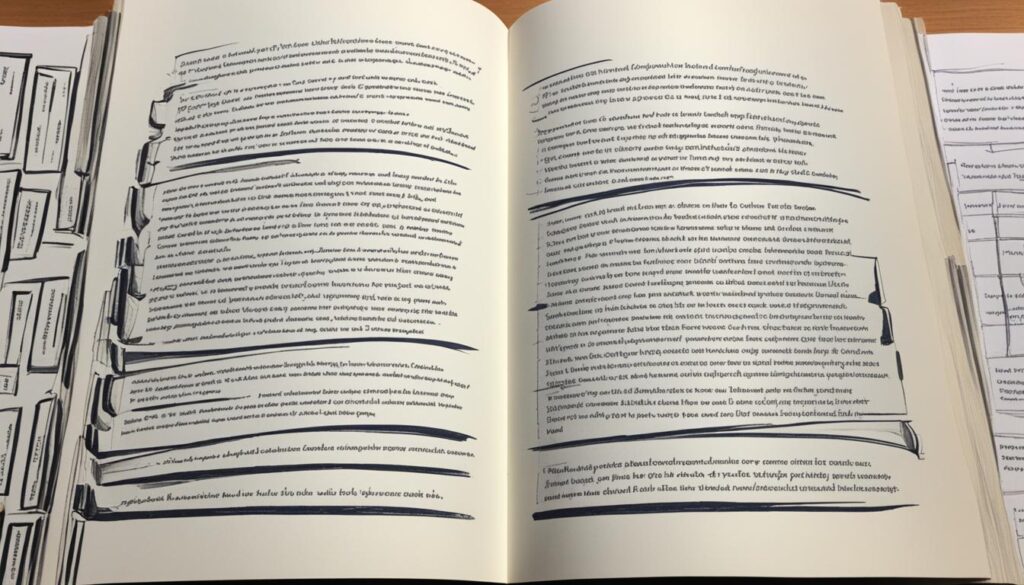Feeling inspired to share your life lessons? Writing a self-help book might be your calling. It’s a journey of self-discovery and a chance to impact lives. I’ll guide you through this transformative process.
Self-help writing is about connecting with readers and offering genuine solutions. Your unique perspective is your greatest asset in personal development literature. Remember, your experiences can truly help others grow.
The self-help genre has a massive audience. Amazon’s Self-Help category boasts over 70,000 titles as of March 2022. This shows the high demand for personal growth content.
You don’t need to be a psychology expert to write a self-help book. Personal experience often trumps academic knowledge in this field. What matters is your ability to relate, inspire, and provide practical advice.
Specificity is key in self-help writing. Narrow your focus to attract readers who’ll benefit most from your insights. Your book could be someone’s beacon of hope in their struggle.
Key Takeaways
- Choose a specific topic for your self-help book for maximum impact
- Understand your target audience’s demographics and motivations
- Research thoroughly, even if you have personal experience
- Analyze existing books to find your unique angle
- Structure your book with a clear outline and practical exercises
- Aim for around 50,000 words in length
- Use real-life examples and data to add credibility
Understanding the Self-Help Genre
Self-help book sales have surged in recent years. Nielsen Book Research reports a 20% increase during the Covid pandemic. This trend shows the lasting appeal of personal growth literature.
Readers seek guidance and ways to improve themselves. Self-help books offer valuable insights and strategies for personal development.
Defining Self-Improvement Literature
Self-improvement books aim to help readers grow and tackle life’s hurdles. They mix personal stories, research, and practical tips. These works give readers tools to boost their lives and reach goals.
Popular Themes and Topics
Self-help books cover many subjects. Common themes include personal growth, productivity, and relationships. Career success, health, and fitness are also popular topics.
- Happiness and mental well-being
- Productivity and time management
- Relationships and communication
- Career development and success
- Health and fitness
The “For Dummies” series shows the wide range of self-improvement areas. It offers books on various topics for personal growth.
Target Audience for Self-Help Books
Self-help books appeal to adults seeking guidance in specific areas. Women show growing interest in self-care beyond traditional wellness. There’s also a rising market for books on longevity and health.
These books cater to readers from all backgrounds. They address common desires for growth and self-improvement.
“Who Moved My Cheese?” a book about adapting to change, has sold over 28 million copies, demonstrating the broad appeal of self-help literature.
Identifying Your Unique Perspective
Your author voice sets your self-improvement book apart. It’s shaped by your personal experience and becomes your unique selling point. Reflect on your journey and challenges to uncover your distinctive perspective.
List your accomplishments and setbacks. What life lessons have you learned? How have you grown? These insights form your narrative and give readers a reason to trust you.

Think about your professional expertise or academic background. Have you read over 200 books recently? Did you overcome obstacles using self-help techniques? These experiences add credibility and help you connect with readers.
“Your unique perspective is born from the intersection of your experiences, knowledge, and passion.”
To showcase your unique perspective, create a table highlighting your key strengths:
| Strength | How It Adds Value |
|---|---|
| Extensive Reading | Provides diverse insights from 200+ books |
| Personal Transformation | Offers relatable stories of overcoming challenges |
| Specialized Knowledge | Brings depth to specific self-improvement areas |
| Writing Style | Engages readers with a friendly, approachable tone |
Your unique voice will resonate with readers. It will make your self-improvement book stand out in a crowded market. Embrace your individuality and let it shine through your writing.
Researching Your Topic
Market research is vital for writing a self-improvement book. Analyze existing self-help books to find gaps in the market. This helps you discover your unique angle.
A study of 21 expert contributions showed that evaluating ideas is crucial. It helps select a book topic that’s both original and relevant.
Analyzing Existing Self-Help Books
Study popular self-help titles to understand current trends. Look for themes that resonate with readers. Find areas where you can offer fresh insights.
This research will guide you in creating a standout book. It will help your work shine in a crowded market.
Conducting Interviews and Surveys
Reach out to your target audience through interviews and surveys. Gather firsthand information about their challenges and needs. This feedback is invaluable for shaping your content.

Gathering Scientific Data and Studies
Include evidence-based advice by collecting scientific data and studies. This adds credibility to your work. It sets your book apart from less-researched self-help books.
Stay connected with your instincts and curiosities during research. This is key for creating engaging content.
| Research Method | Benefits | Challenges |
|---|---|---|
| Market Analysis | Identifies market gaps | Time-consuming |
| Interviews | Direct audience insights | Finding willing participants |
| Scientific Studies | Adds credibility | Interpreting complex data |
Combine these research methods to create a truly helpful self-improvement book. Balance your unique perspective with solid, evidence-based advice. This approach will make your book both marketable and valuable.
Crafting Your Book’s Structure
A solid structure is vital for a successful self-help book. Your outline lays the groundwork for an engaging personal growth journey. Let’s dive into creating an effective structure that connects with readers.
Creating a Compelling Introduction
Your introduction sets the tone for your book. Share personal stories and highlight your expertise to captivate readers. Include a strong call to action that inspires them to keep reading.
This approach builds trust with your audience. It also prepares them for the transformative journey ahead.
Organizing Chapters and Sections
Well-organized chapters are crucial for a smooth reading experience. Begin by listing 10-15 subtopics related to your main theme. Arrange these topics logically, either by themes or difficulty level.
This thoughtful organization guides readers effortlessly through your content. It helps them absorb and apply your insights more effectively.

Developing Exercises and Action Steps
Include self-help exercises throughout your book to boost reader engagement. These hands-on activities help readers apply your advice to their lives. Aim for 80% actionable content and 20% theory.
This balance maximizes reader involvement and results. It turns your book into a practical tool for personal growth.
| Book Component | Purpose | Recommended Content |
|---|---|---|
| Introduction | Establish credibility and set expectations | Personal experience, expertise proof, call to action |
| Chapter Structure | Guide readers through content | Logical order, themed or difficulty-based progression |
| Exercises | Encourage application of concepts | Practical activities, reflection prompts, action steps |
| Content Balance | Maximize reader engagement | 80% actionable tips, 20% theoretical background |
A well-crafted book structure boosts readability and impact. Focus on these key elements to create a powerful self-help book. Your readers will connect with your message and experience real change.
How to Write a Self Improvement Book

Creating a self-improvement book needs careful planning. Start with a clear outline dividing main ideas into chapters. Aim for 12 chapters, each about 5,000 words long. This structure helps explore your topic deeply while keeping readers interested.
Focus on giving value to your readers. Include real-life stories and practical guidance. Add interactive exercises to help readers apply your ideas. Great self-help authors inspire action, not just share information.
Here are some key self-help author tips to keep in mind:
- Write in a conversational tone, as if speaking to one ideal reader
- Break down complex ideas into simple, actionable steps
- Use personal anecdotes to illustrate your points
- Include exercises, quizzes, and journaling prompts
- Provide clear takeaways at the end of each chapter
Think about how your book can inspire broader positive change. Many readers want to grow personally and contribute to society. Address this desire to create a more impactful book.
Incorporating Personal Stories and Examples
Storytelling in self-help books makes complex ideas relatable and memorable. Personal stories transform abstract concepts into practical wisdom. They create a powerful connection with readers, bringing ideas to life.
“Rich Dad, Poor Dad” by Robert Kiyosaki uses relatable experiences to explain financial principles. This approach makes challenging topics accessible to many people. It shows how personal narratives can effectively convey complex ideas.

Studies show that 80% of readers grasp information better when presented through stories. This finding highlights the value of using relatable experiences in your book. It can potentially boost your informed readership by 50%.
Aim to balance personal anecdotes with factual information in your writing. This method keeps your book credible while engaging readers emotionally. “The Definitive Book of Body Language” is recommended by 90% of readers.
Include diverse and inclusive stories in your book. This approach helps your advice resonate with a wider audience. It makes your insights applicable to various life situations.
Master the art of storytelling in self-help writing. You’ll create a book that deeply resonates with your readers. Your words will have a lasting impact on their lives.
Editing and Refining Your Manuscript
A polished self-improvement book is key to success. Let’s explore essential steps to elevate your manuscript.
Self-editing Techniques
Review your manuscript with fresh eyes. Use Autocrit to analyze pacing, dialogue, and repetition. The Book Editing Blueprint course helps spot common writing mistakes.
Try a Text to Voice app to catch overlooked typos and misspellings. These tools can significantly improve your manuscript’s quality.
Working with Beta Readers
Beta reading provides valuable reader feedback. Platforms like Scribophile connect you with critique partners in your genre. Beta readers offer insights on your target audience’s perception.
Their feedback helps refine content and structure. This process can greatly enhance your book’s appeal.
Hiring a Professional Editor
Professional editing services can transform your manuscript. With a 4.6/5 rating from 2,346 reviews, these services offer thorough refinement.
They improve grammar, style, and structure. Authors praise the enhancements in language consistency, phrasing, and storytelling flow.
| Editing Type | Focus | Benefits |
|---|---|---|
| Developmental | Overall content and structure | Improves organization and flow |
| Line Editing | Sentence-level review | Enhances clarity and readability |
| Copy Editing | Grammar and consistency | Ensures error-free text |
| Proofreading | Final polish | Catches any remaining errors |

Combine self-editing, beta reading, and professional editing for best results. This approach creates a polished manuscript ready to inspire readers.
Choosing a Title and Cover Design
A short, catchy title is key for self-help book marketing. Focus on a single concept that captures your book’s core message. Your title should match the book’s tone and give readers clear expectations.
Consider hiring a pro for cover design if possible. If not, focus on four main elements: front cover image or text, font choice, blurbs, and finish. Text-only covers can be effective, as seen in many bestsellers.
Use unique, high-res photos or illustrations at 600 DPI or higher for print quality. Choose two font types, mixing serif and sans-serif for the title and subtitle. Avoid outdated design elements like shadow effects or overly cursive fonts.
Pay attention to text alignment and line spacing. These details can make your cover look professional. Your book’s look is your first chance to grab a reader’s attention.
In 2019, 85,253 new self-help titles were published. A great title and cover can help your book stand out in this crowded market.










